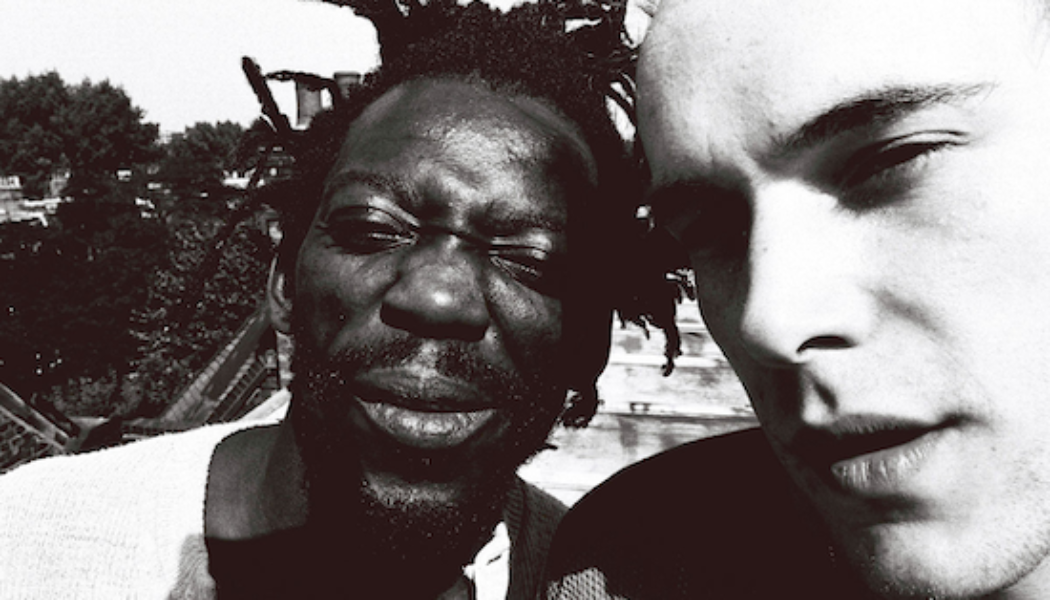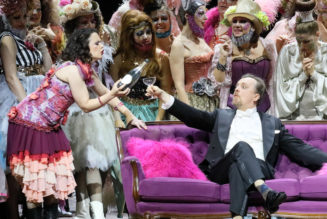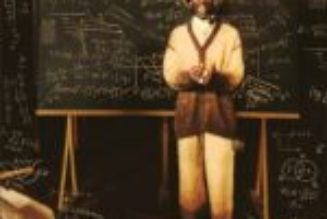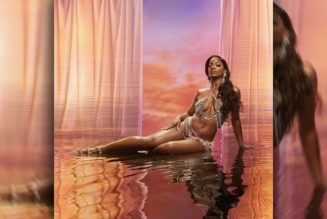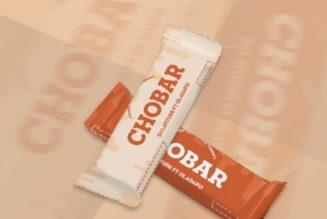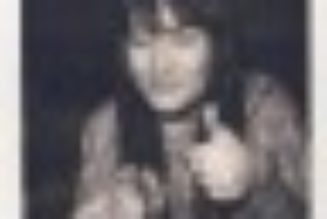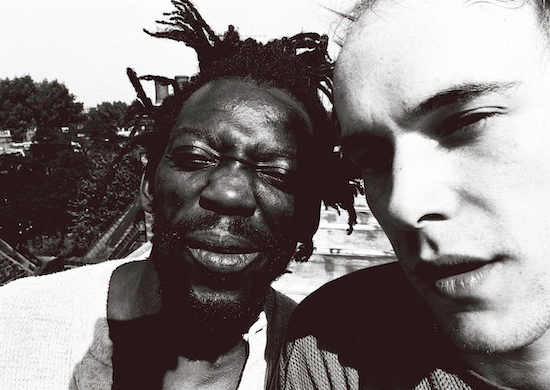
The African Head Charge project is led by producer Adrian Sherwood and Jamaican percussionist Bonjo Iyabinghi Noah and started off as a combination of traditional Rasta drumming (including percussion instruments that had become neglected in reggae before AHC’s debut) and Sherwood’s experimentation with cut-up collage and rule-breaking approaches. They’re part of On-U Sound, which is not just a record label but a collective of musicians from different styles merging together for a variety of dub-based ventures, most of them playing across different projects simultaneously.
Over four decades, African Head Charge have been on a fascinating journey. The off-the-wall, extended dub techniques of the band’s first four albums in the 1980s marks them as a crucial cornerstone in the development of their genre. The early albums, dubbed as “Science Fiction Dancehall”, the title of Trevor Jackson’s compilation of selected early On-U releases, is a metropolitan sound from an urban interior; factory fumes intermingling with the uprooted souls of colonial trauma and working-class poverty. Veering away from reggae, these records highlight Sherwood’s unconventional production, crafting dub as a twisted psychedelic embellishment with Bonjo’s trippy and ecstatic drumming. African Head Charge captured the essence of a society grappling with its contradictions. It is the sound of diasporic cultures coming together not as an exotic, consumable sharing platter but as an army of resistance. The production style deliberately veered off the beaten track, a creative trajectory encouraged by Adrian’s good friend, provocateur extraordinaire, the late Mark Stewart of The Pop Group.
Bonjo was a first-generation Rasta baby. Trained in the Nyabinghi drumming practice at his local Rasta church, he knew the Reverend Claudius Henry, founder of a fully-fledged guerilla movement in independent Jamaica. Every Saturday as a kid, Bonjo would play the drums in the Rasta camp, which functioned as a refuge for those at risk of being murdered by the Jamaican government at this time. As a child, he remembers hearing news of people in his close-knit community – friends, family members, and drum teachers – being sentenced to death by hanging. Despite this practice being outlawed in Britain, the “mother country”, it continued in Jamaica. Bonjo moved to London at the age of 16.
African Head Charge began in 1981 with the release of My Life In A Hole In The Ground, a reference to the dingy basement studio space on Berry Street where it was made, but also to Brian Eno and David Byrne’s My Life In The Bush Of Ghosts, which was released during the same year – a pioneering, sample-based album of tape collage combining electronic dance music with traditional music from the Global South. The name-echoing was at least somewhat a bid to get noticed in an over-saturated market place, but on a deeper level, African Head Charge could be seen as having appropriated the appropriators.
Keeping experimentation and organic collaboration at the forefront of their approach, the early African Head Charge project had marked differences from the ethno-musical tourism of Eno and Byrne. Whilst Sherwood cites Eno as an evident influence, exemplified by a penchant for ‘borrowing’ sounds from all over, AHC have their feet firmly planted in Afro-Futurist emancipation in a genuine, collaborative and integrated way. The AHC project serves as a platform for Bonjo’s musical and spiritual pilgrimage, an impressive lifetime achievement culminating in travels from his base in Ghana and across the continent, learning the drumming techniques of different tribes. Their latest album, A Trip To Bolgatanga, marks a ground-breaking new chapter of a culturally significant and vital ethnomusicological story and serves as an antidote to the cultural imperialism of world music. Because here, the ethnographic fieldwork is carried out by someone doing it not for appropriative reasons but because they feel an innate calling; it is the fulfillment of a cultural dream stemming from the deepest respect for ancestral heritage.
‘Far Away Chant’ from My Life In A Hole In The Ground (1981)
Adrian Sherwood: “All our reggae peers wouldn’t go near recording [traditional Rasta percussion] thunder drums or congas. Bonjo liked Cuban music; he’d studied jazz and other things and played in different bands. I had credit at this studio called Berry Street. When I started the project, I wasn’t trying to emulate Eno’s thing exactly but just the idea of experimentation with African music. When he said ‘I have a vision of a Psychedelic Africa’, I thought what a great idea, something trippy for the weed smokers and acid casualties, but it wasn’t just African. We used the name ‘African’, but our music had the spirit of Africa, Jamaica, and Cuba, of course Cuba’s African as well because of diasporic influence. I had read about other people’s experimental studio techniques – Conny Plank, Brion Gysin, William Burroughs; tape cut-ups and manipulation. We had Prince Far I record a track for us. It was OK on the rhythm, but then I slowed it right down and put it over another rhythm, and we were just cutting rhythm after rhythm after rhythm, and that track ended up being in David Lynch’s Wild At Heart, slowed down even more in the torture scene.”
‘High Protein Snack’ from Environmental Studies (1983)
AS: “With Environmental Studies, we had access to Deadly Headley, a saxophonist who played with Prince Far I. A lot of the great Jamaican musicians had references to jazz, some preferred one style to another, but Headley had that beautiful alto sax. I also met Nick Plytas of Roogalator, we worked on the On-U Sound Judy Nylon album [Pal Judy, recorded with Crucial]. And my then-wife, Kishi Yamamoto, a classically trained, brilliant musician, added Japanese classical stuff veering into… whatever. We were all listening to a Ghanaian highlife album, emulating the cheesy synths but distorting them. It comes back… You listen to it now, and it’s still got hints at Ghana even then, so the flavours were there.”
‘Bazaar’ from Drastic Season (1983)
AS: “We thought, well, there’s no point making traditional African or funk records. [The production of this record was influence by Mark Stewart who persuaded us to divert from dub norms]… he was so important in pushing things right off-centre and challenging with his approach to things.”
‘Language And Mentality’ from Off the Beaten Track (1985)
This seminal Albert-Einstein-sampling track was developed on a busy day of juggling between three separate On-U projects which were collaborative while maintaining a unique character.
AS: “We were working one day, we had a pile of tapes and multi-tracks in the studio, African Head Charge, Mark Stewart and the Maffia, and Singers and Players all on the same day for the same session, everyone in the back room smoking weed and doing whatever. We jumped from one record to another. So we took everything off the track ‘Jerusalem’ [Mark Stewart and The Maffia], and were left with the drumming which sounded really heavy and druggy. I loved it. Then it was a case of, ‘OK, let’s use this track as a mainstay for the next [African Head Charge] record.’ Then it was a case of putting Albert [Einstein] on it, touches of very minimal melody and a proper mix. If you listen to ‘Language And Mentality’, the bassline is actually the melody of ‘Jerusalem’. I started playing the [‘Jerusalem’] melody as the [‘Language And Mentality’] bassline; then, we overdubbed Albert Einstein to make it.”
‘Hold Some More’ from Songs Of Praise (1990)
As African Head Charge moved into the 90s they moved away from being an experimental studio-only outfit towards becoming a band with a more song-writing based practice who often played live, which gave Bonjo more leadership.
AS: “Bonjo came up with the ‘Hold Some More’ song; it started with sampled [Arabic] vocals, then bass and guitar; the great Skip Macdonald provided beautiful guitar licks. I distorted the chant, fucked it up – I discovered it somewhere – and from what Bonjo’s ears were hearing, he’s responding, singing ‘Hold some more!’, his vocals mirroring the chant. ‘Hold some more’ means, ‘Look, we deserve to get paid better.’ That’s what it means.”
Bonjo: “‘Hold some more’ means ‘more’. Getting more out of what you’re doing, y’know? So no matter where we go, over the hill, over wherever – we’re going to hold some more.”
AS: “‘We can’t get ripped off anymore.’ Great song, still is to this day, one of the mainstays of the African Head Charge set; I don’t mind doing it any time. I love it.”
‘No Don’t Follow Fashion’ from In Pursuit Of A Shashamane Land (1993)
The year after the release of In Pursuit Of A Shashamane Land, Bonjo left London for Ghana and began his embodied practice, embracing and learning different African drum styles from communities across the continent.
B: “The only thing I can remember about Shashamane is that I think it was like all those years before. We were experimenting, but now we started to develop as well so it was different from before. [It was a mental, physical and spiritual preparation for immersion in the music and culture of the homeland.] That’s why Pursuit Of A Shashamane Land is called that. Pursuit means wanting to go someplace.”
AS: “It’s the Rasta dream.”
B: “It is part of our dream, and [the name] Shashamane, doesn’t just refer to Ethiopia, it represents all of Africa, so that’s why that album was like that because at that time, I was getting my spirit strong for Ghana, and Africa.”
‘Drumming Is A Language’ from Vision Of A Psychedelic Africa (2005)
B: “I firmly believe, if you listen to some [of our] songs sitting quietly by yourself and meditating… I know for a fact it can bring the ancestral family very close; they like certain vibes from the music. I’m talking about meditation music. Certain things in the morning, certain things for dinner, and certain things for supper. That’s why I know when you check out African Head Charge music, you get this wide variety. I remember why I took the drums so seriously. There was a hospital I used to work at as part of Hackney community workshops while I was unemployed and doing nothing – we used to go to different places to play in the community, such as hospitals where people were injured. The drumming was like medicine to them. I’ll never forget this as long as I live; we went into the hospital one day, and this man was lying there in a coma; doctors said he wasn’t moving for a few days or something like that, so we start to play some very rough type of drumming. Some drumming is soothing, and some other drumming can break up the heartbeat and whatever, and this man started to move his fingers, and the doctor said: ‘We have been trying to get this man to move for the past couple days and he wouldn’t move anything!’ After that day, I started to understand that the drum is like something you receive on a different level, not just as a musical instrument, but also something that can heal.”
‘This And That And The Other’ from Voodoo Of The Godsent (2011)
AS: “At the time, I wasn’t in very good shape, I have to be honest. I’d left London and things weren’t going well. I went through depression for several years. It’s why it’s good to have positive friends around; we had people like Lee Scratch Perry and Doug Wimbish. Upful spirits. You need your friends around to lift you up when you’re feeling down. We made the album in about twelve days. I’m glad we made it. Sure, if I was given a chance to make the album with the ideas we had then but to play it now, I would probably do a bit more work on it, but I’d just moved to Ramsgate.
B: “[That’s] one of the powerful songs for me. As Adrian said, we were all going through certain things, and because of what we were going through, that album is what came out. The lyrics mention ‘hotter hotter fire’, and this track has a meaning. [When experiencing hard times] some people smoke themselves to death. I used to get up every morning and go and run for about six or seven miles. And that’s when this song came into my head, hotter hotter fire, putting up with people trying to fuck with you, [metaphorically] burn them up.”
‘More Bizarre’ from Return Of The Crocodile (2011)
Return Of The Crocodile is a compilation of AHC’s more left-field early experimentation
AS: “We’ve got a friend called Patrick Dokter, the On-U Sound archivist. He’s a total bipolar-lunatic-darling. He’s family. He’s absolutely mad, but I mean that in the nicest way. We love Patrick, bless his heart. He literally took hundreds of leftover tapes I had in the attic, scoured through everything and came up with these leftovers of our tracks and created a couple of records, so bless him. If it wasn’t for him I wouldn’t have done it! Pat acted as A&R for Bonjo and me on those records.”
‘A Bad Attitude’ from A Trip To Bolgatanga (2023)
A Trip To Bolgatanga features artwork from Peter Harris who collaborated with the late Lee Scratch Perry. Thanks to Llyr Williams’ animations, the music videos bring his artwork to life. It is a post-colonial provocation of reclaiming African art from Picasso, an idea Peter and Adrian developed in response to the African art Bonjo would bring back from Ghana. For ‘A Bad Attitude’ Harris incorporates characters, the ‘Cubist Yobs’, further enhancing this brilliantly pointed satire and working-class response to modernism.
AS: “Peter is a great artist, and he started sending me images of Lee Perry when they worked together. It looked like Picasso, but Picasso nicked so much of his style from African art. Right from Bonjo’s first trip to Africa, he’d bring me back a mask and then a second mask. Over the years, I had [a collection of] some wonderful masks. And when you’d look at them, they’d have the look of Picasso, who, by his own admission, nicked this stuff from the Africans. Peter used the inspiration of the history of African art merging it with psychedelia.”
B: “I went to a place called Bolgatanga, and when I was talking to Adrian, he said, ‘Let’s call the album A Trip To Bolgatanga“
AS: “It’s a double meaning: you go there, and you can get stoned!”
B: “Bolgatanga is in the north of Ghana, next door to Burkina Faso, so I went there, and I met some musicians like King Ayisoba [the vocalist on ‘A Bad Attitude’] and lots of different types of drummers.”
AS: “So on this record, Bonjo recorded King Ayisoba and other musicians while he was in Africa. During the lockdown, we sent files from Africa to Ramsgate; we’d recorded things in England and sent them off to America for the great Doug Wimbish to add bass. It was a great experience doing it that way, because we weren’t rushed; this gave us a chance to relax and say, ‘We’ll do this tomorrow and do the next bit then…’ And all the right people came in.”
B: “I plan to keep working this way when I go to Africa. It’s not just going there because I have family, children, and grandchildren but to meet different tribes. I want to continue to learn more about their drumming; the language is a bit difficult for me, but the drumming I can relate to it.”
This article is dedicated to the late Mark Stewart. A Trip To Bolgatanga is released on Friday via On-U Sound
